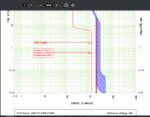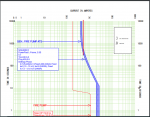PE (always learning)
Senior Member
- Location
- Saint Louis
- Occupation
- Professional Engineer
This is my last post for the week, I promise!
I have a question pertaining to the instantaneous setting of a breaker that feeds a fire pump from a standby generator. I've been hired to do a power systems study and I need to provide settings for this breaker in question that I mentioned above. After reading through NEC 695.4(B), I found this statement, "Overcurrent protective devices between an on-site standby generator and a fire pump controller shall be selected and sized to allow for instantaneous pickup of the full pump room load, but shall not be larger than the value selected to comply with 430.62 to provide short circuit protection only."
Let me know if I'm interpreting this correctly please. It is my understanding that they want you to set the instantaneous portion above the locked rotor current, but still abide by 430.62 which makes you follow table 430.52, which only allows you to set the instantaneous portion at 800% of the full load current. This is so you protect against short circuits and don't destroy the generator in the event that a fault occurs and continue power to other sources that the generator may feed.
In my scenario, 800% of the full load current doesn't get me above the inrush current being put out by my fire pump motor. I have set my instantaneous beyond the suggested 800% maximum shown on table 430.52. In my scenario, the only other loads that are fed by the generator are IT equipment loads and the emergency lighting is fed by battery backup. I feel that the importance of my fire pump running outweighs losing power to IT equipment. Would it be acceptable in this scenario to disregard the 800% max required from 430.52?
I have a question pertaining to the instantaneous setting of a breaker that feeds a fire pump from a standby generator. I've been hired to do a power systems study and I need to provide settings for this breaker in question that I mentioned above. After reading through NEC 695.4(B), I found this statement, "Overcurrent protective devices between an on-site standby generator and a fire pump controller shall be selected and sized to allow for instantaneous pickup of the full pump room load, but shall not be larger than the value selected to comply with 430.62 to provide short circuit protection only."
Let me know if I'm interpreting this correctly please. It is my understanding that they want you to set the instantaneous portion above the locked rotor current, but still abide by 430.62 which makes you follow table 430.52, which only allows you to set the instantaneous portion at 800% of the full load current. This is so you protect against short circuits and don't destroy the generator in the event that a fault occurs and continue power to other sources that the generator may feed.
In my scenario, 800% of the full load current doesn't get me above the inrush current being put out by my fire pump motor. I have set my instantaneous beyond the suggested 800% maximum shown on table 430.52. In my scenario, the only other loads that are fed by the generator are IT equipment loads and the emergency lighting is fed by battery backup. I feel that the importance of my fire pump running outweighs losing power to IT equipment. Would it be acceptable in this scenario to disregard the 800% max required from 430.52?
Last edited:


